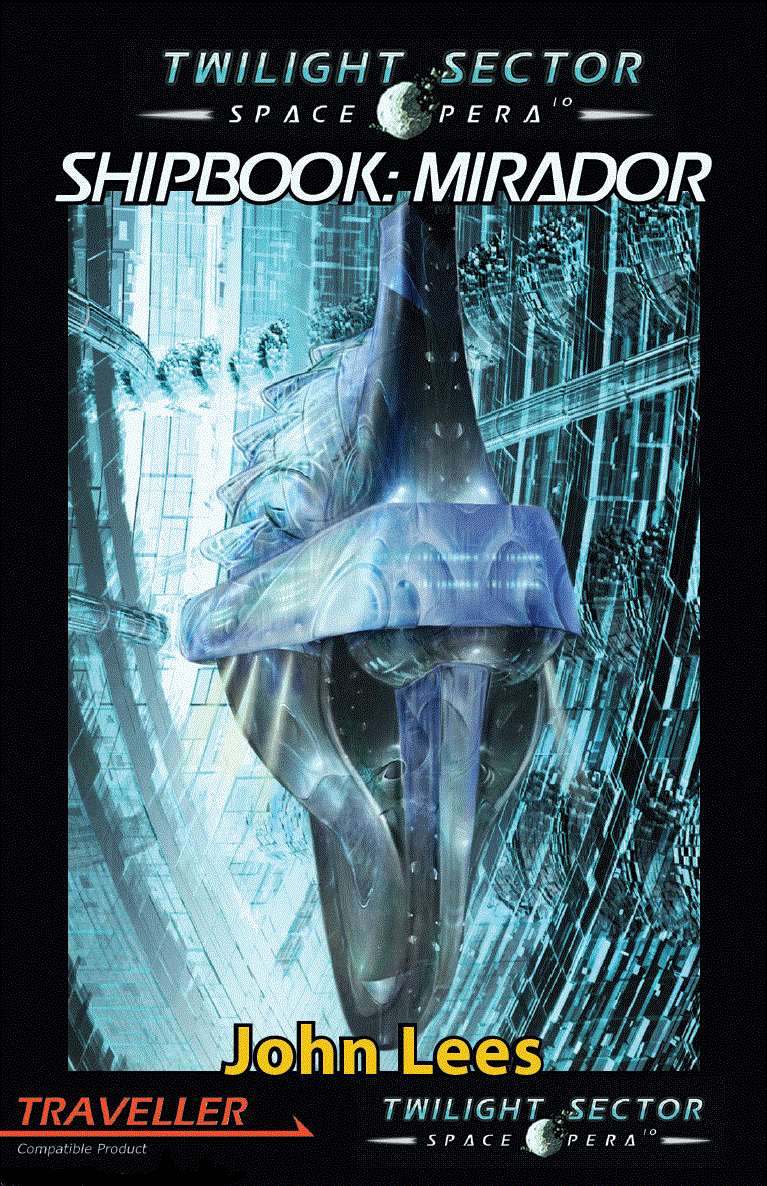Shipbook: Mirador
This article originally appeared in the September 2014 issue.
 Shipbook:
Mirador. John Lees
Shipbook:
Mirador. John Lees
Terra/Sol Games http://www.terrasolgames.com
92pp, PDF
UKŁ3.85/US$5.99
Editor’s Note: Some readers may recognize the illustration on the cover (and on page 52) as having appeared on Freelance Traveller’s March 2012 issue. The illustration was offered to us by Terra/Sol Games, and they have our thanks for permitting its use in that fashion.
Good ship material has been hard to come by in Traveller; often, descriptions are sketchy or nonexistent, or deckplans don’t match data sheets and descriptions. Shipbook: Mirador breaks the trend, at least for Terra/Sol’s Twilight Sector setting.
The Mirador-class is presented as more than a strict utilitarian ship; rather, the author indicates that the idea of luxury, rather than efficiency, was designed in from the keel up, while keeping the ship at a manageable (reasonable for the PCs to be principals on) 1,000 tons displacement.
The meat of the book starts with some discussion on ship interiors, most of which is probably assumed understood by most players—but which is ultimately probably better for being stated, to ensure that everyone is “on the same page”. Since there are some differences between a ‘stock’ Traveller universe and Terra/Sol’s universe, understanding the Terra/Sol perspective, even in what could be viewed as ‘trivial’ things, is a good thing for anyone wanting to use the Mirador outside their setting. (One example is the use of “zero-G” [really “centigravity”, hundredths of a G] shafts as a possible means of travel between decks. Another is the explanation and use of ‘overage’ in the deckplans.)
As noted, the Mirador is, at heart, a luxury cruiser, and the detailed deck-by-deck ‘standard configuration’ description that follows is for the ship set up in this mode. The design is for about 50 passengers, with a crew of 17 (assuming six gunners and three stewards). The deck plans are fairly conventional, though the various icons (for chairs, consoles, et cetera) are slightly more detailed than established conventions.
Deck plans, which appear to be 15mm-compatible if printed out on 5˝×8˝ paper (but watch the notes on decks 9—12!), appear side-by-side with text descriptions, though no effort appears to have been made to align the plan for a deck with the beginning of the deck’s text description. The text does note when an area is built around a repurposed component (e.g., the ship’s bar from a standard chem lab plus overage), which serves to point out that referees and ship designers should feel free to use their imaginations to achieve their design goals.
Following the look at the standard Mirador is a section focussing on Excelsior Tours, a small corporation that uses two Miradors to provide luxury transport on a single route. This section gives a close look at the major personalities of the corporation, and its history and operations, but it also notes where the corporation’s Miradors differ from the standard (in the details and utilization; structurally, they’re pretty much ‘stock’). The personality overviews are enough to make them distinctive NPCs, and each is illustrated, but the illustrations are disappointingly cartoonish; with rendering programs like DAZ3D and Bryce being a dime (or less!) a dozen, and even game programs like The Sims (and its successors) being able to do credible ‘renderoids’ of people for head-and-shoulders ‘photography’, there really isn’t a reason that these couldn't have been far better than they are.
The section on Excelsior Tours concludes with an assortment of adventure seeds, from one-shots to options for continuing campaign involvement.
The next section looks at the RSS Rosalind Franklin, a Mirador modified to be a research ship rather than a luxury transport. This section starts with a look at Dr Talia Mason, the owner, and how she came to acquire the ship. A full-page ‘sidebar’ discusses how it was ultimately financed, in terms of how PCs might be able to afford to do it. This is followed by an in-depth look at the ship itself, and it is noted here that the Rosalind Franklin has a mirrored finish, and it is this ship that is shown in the cover illustration (and on page 52, and on the March 2012 Freelance Traveller).
The Rosalind Franklin is a ‘working’ ship, and while still luxurious, does not provide steward service (reducing the crew to fifteen—there is an extra gunner). The major change is that the staterooms on Decks Five through Eight are swapped out for labs of various types, and modified plans for these decks (plus Deck Four, which has also had some changes) are provided in this section.
The section closes with another set of adventure seeds, this time using the Rosalind Franklin and her ‘mission’ as the focus, and with a brief discussion of the economics of the Rosalind Franklin.
The book closes out with a set of alternative trade rules for passengers and cargo, and notes that these rules, rather than those in the Mongoose Traveller Core Rulebook, are the default assumed rules for trade in the Twilight Sector setting.
Overall, this product is worth the money as a PDF, but it would be hard to say whether a print version—at likely two-to-three times the price—would be as good a value. You get a good look at a ship in two different configurations, and with a lot of background material, and good (if unspectacular), readable deck plans—but the deckplans would take a bit of resizing work to make them usable with miniatures. Artwork is a bit scanty, and what there is really can’t be characterized as other than ‘uninspiring’. On a five-scale, I can’t really give this more than a generous three-and-a-half—but a flat three would be too low.
 Freelance
Traveller
Freelance
Traveller